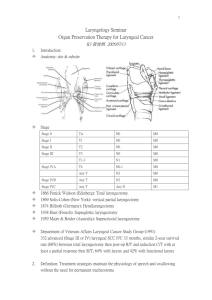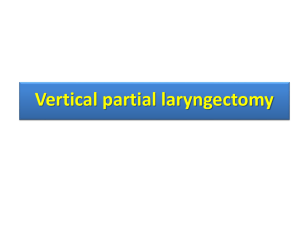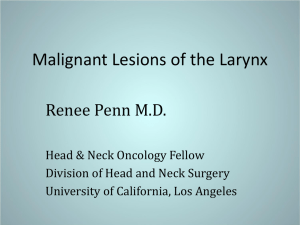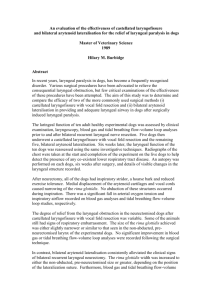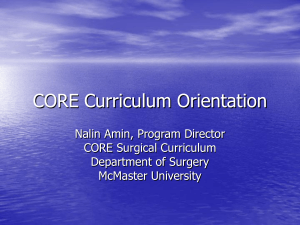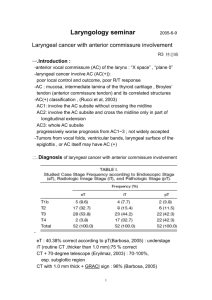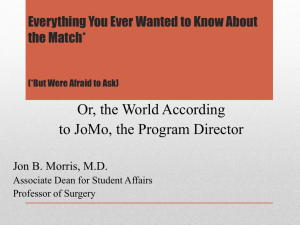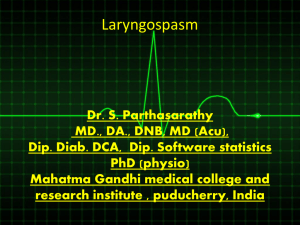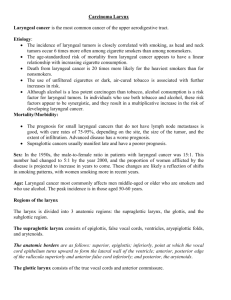Conservation laryngeal surgery
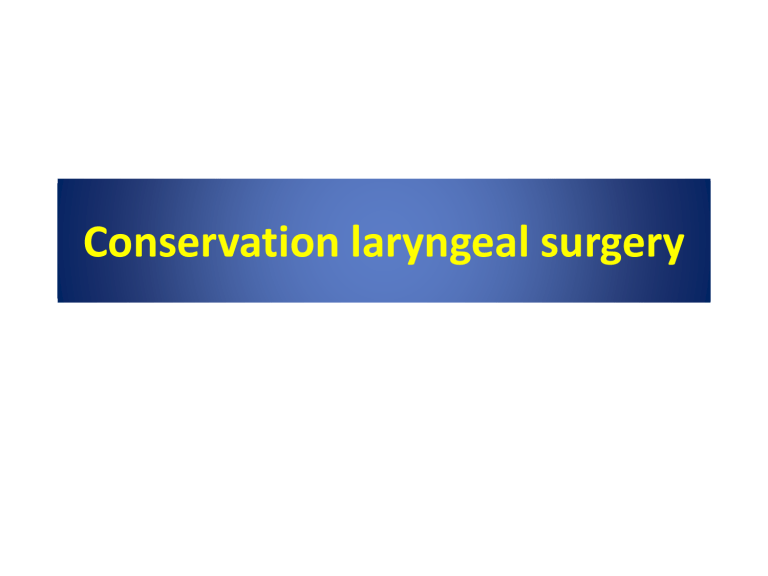
Conservation laryngeal surgery
Reference
• Cummings otolaryngology head and neck surgery, 5 th edition , chapter 110 ; conservation laryngeal surgery P. 1539-1562
• Cummings otolaryngology head and neck surgery, 4 th edition
• Bailey BJ. Atlas of Head & Neck Surgery
Otolaryngology Otolaryngology. 4 th Edition.
• Bailey BJ. Head & Neck Surgery –
Otolaryngology. 5 th Edition
• Atlas of head and neck surgery. 2 nd edition; 1999
Introduction
Conservation laryngeal surgery
Preserve speech and swallow function without permanent tracheostomy
high local control rate same total laryngectomy
Principles of organ preservation surgery
• First principle: Local control
• Second principle: Accurate assessment of three-dimensional extent of tumor
• Third principle: Cricoarytenoid unit is basic functional unit of larynx (swallowing ,
Respiration,Phonation and airway protection)
• Fourth principle: Resection of normal tissue to achieve an expected functional outcome
Laryngeal framework
• Only complete skeletal ring of airway compare with signet ring
• Allow for decanulation after conservation laryngeal surgery
Cricoarytenoid unit
• fundamental functional unit of the larynx
• one arytenoid cartilage with its associated cricoarytenoid musculature and recurrent and superior laryngeal nerves
• Preservation of one cricoarytenoid unit with the associated cricoid ring allows for speech and swallowing without a permanent tracheostomy.
Cricoid , Arytenoid
Muscle: PCA, LCA, interarytenoid
Nerve: SLN, RLN
• Petiole เกาะกึ่งกลางของ thyroid cartilage โดยมี fibrous tissue ประสานไป
กับ Broyles’ ligament.
• Suprahyoid
• Infrahyoid fenestration
• CA supraglottic may invade preepiglottic space through the fenestration
Condensations of fibrous tissue of larynx
• Arise from sup. portion of cricoid cartilage to join with inferomedial part of vocal ligament of vacal cord
Condensations of fibrous tissue of larynx
• temporary barrier for the spread of early glottic carcinoma
• But for larger cancer ,gateway to subglottic and extralaryngal spreading
• Sup. border of membrane is free and oblique and thickening to form aryepiglottic fold.
• Inf. ; extend from infr point of epiglottis this attach to thyroid cartilage to insert arytenoid
• Inf. border are thickening to form vestibular fold; a part of false vocal cord
Broyles ligament: or anterior commissure tendon, devoid of perichondrium
Thyrohyoid membrane: extension out of the larynx through the thyrohyoid membrane alone is rare, typically seen when cancer exit larynx through upper portion of thyroid cartilage
Hyoepiglottic ligament
• Resilient barrier to malignant spread from the supraglottis to BOT
• When cancer confined to laryngeal membranes does not clinically invade the suprahyoid epiglottis
Ant. surface; thyrohyoid m.
Sup. surface; hyoepiglottic ligament,valleculae
Post. surface; epiglottis
Inf. surface; thyroepiglottic ligament
• Contain lymphatic tissue, vessels, fat.
• CA supraglottis invasion to this space through fenestration of epiglottis
•Inferomedial ; conus elasticus
•Anterolateral ; thyroid ala, abut preepiglottic space
•Superomedial ; quadrangular membrane
•Posterior ;medial wall of pyriform
•Inferior ; adjacent to cricothyroid m.
• Tumor invade to extralarynx through cricothyroid m.
Lymphatic drainage
• Lymphatic drainage sparse anteriorly and at glottis
• Rich lymphatics in supraglottis, subglottis, posterior half
• Barriers to spread
1) Conus Elasticus inferiorly
2) Quadrangular
Membrane laterally
3) Thyrohyoid Membrane superiorly
Preoperative evaluation
1) Assess oncologic of primary site, regional nodes, and distant sites (TNM staging)
2) Assess patient's ability (medical undergo surgery and postop.)
3) Patient and family insight, emotional state, and ability and willingness to postop.
Rehab.
Oncologic assessment
• Degree of airway impairment and voice quality
• Arytenoid and vocal cord mobility
– Glottic CA :
• Impaired mobility TVC may be result of superficial TA invasion or bulk on surface of cord in exophytic lesion
• Fixed TVC most common results from extensive invasion of TA m.
Oncologic assessment
– Supraglottic CA :
• Pseudofixation : arytenoid motion impaired superiorly causing from "weight impact" of tumor
• Actual fixation : malignant involvement of intrinsic laryngeal muscle, cricoarytenoid joint, or both
Oncologic assessment
• Extensions out of endolarynx :
– Palpate thyroid cartilage for irregularities
– Areas directly above and below thyroid cartilage
• Bulge or mass at level of thyrohyoid membrane may indicate massive preepiglottic space invasion
• Mass at level of cricothyroid ligament may indicate delphian lymph node, which indicates subglottic extension of malignancy
AJCC Staging Glottic cancer
AJCC Staging Supraglottic cancer
Assessment of patient's ability
• Aging and chronic lung obstructive disease increase risk of postoperative atelectasis/pneumonia
• Lung function test controversy
– Some authers: routinely for all patients
– FEV-1 < 50-60% of expected for age predicts high risk of pulmonary complications
– Ability to walk up 2 flights of stairs without getting short of breath better predictor of post-op complications good candidates for conservation sx
• Good cognitive function, consent for intra-op TLG
• Aim: Good life activity, Good control local
Conservation laryngeal surgery
Endoscopic
Surgery
Open
Surgery
Glottic cancer
Transoral laser microsurgery
• Vertical partial laryngectomy
• Vertical hemilaryngectoym
Horizontal Partial
Laryngectomies
• Supracricoid Partial
Laryngectomy with
Cricohyoido-Epiglottopexy
(SCPL with CHEP)
• Extended
• FRONTOLATERAL VERTICAL
HEMILARYNGECTOMY
• Anterior frontal vertical hemilaryngectomy
• POSTEROLATERAL VERTICAL
HEMILARYNGECTOMY.
• EXTENDED VERTICAL
HEMILARYNGECTOMY.
EXTENDED PROCEDURES.
Supraglottic cancer
Transoral laser microsurgery
Horizontal Partial
Laryngectomies
• Supraglottic Laryngectomy
EXTENDED PROCEDURES
• ARYTENOID, ARYEPIGLOTTIC FOLD, OR
SUPERIOR MEDIAL
PYRIFORM INVOLVEMENT FROM
SUPRAGLOTTIC CARCINOMA.
• BASE OF TONGUE EXTENSION FROM
SUPRAGLOTTIC CARCINOMA.
Supracricoid Laryngectomy with Cricohyoidopexy (CHP)
EXTENDED PROCEDURES.
Principles
• Endoscopic laser resection can encompass smaller lesions without transgressing tumor
• Larger tumors are best managed with controlled resection in several pieces
• Image B: Microscopic evaluation of the cut surface
• C, Small vocal fold lesions can be resected as a single specimen with care to keep a 1- to 3-mm distance about the lesion and to mark it appropriately to confirm clear margins histologically
Ref: Cumming Figure 100-10
Classification by European laryngological society 2007
Type I
Type III
Type II
Type IV
Type Va
Type Vc
Type Vb
Type Vd
Cordectomy type VI
Classification by European laryngological society for supreglottic CA
Endoscopic cordectomy
Reference : www. medscape.com
TLM for T1 glottic cancer
Endoscopic laser surgery for T2 supraglottic cancer
Pre-treatment Post-resection
Indications
• Early glottic cancer (T1 and T2 stages)
• Select cases T3 lesions
• Not be appropriate in cases of recurrent glottic carcinomas
Contraindications
• Large T3 or any T4 lesions
• Arytenoid fixation (CA joint)
• Interarytenoid, postcricoid invasion
• Cricoid invasion (subglottic extension >10 mm anteriorly; >5 mm posteriorly)
• Bulky transglottic lesion
• Massive Pre-epiglottic space invasion
• Lesions extending beyond external thyroid perichondrium
Laryngofissure & cordectomy
• For midcord mobile
T
1
CA glottic cannot resect endoscopic because of anatomic constraint preventing adequate laryngoscopic exposure
Laryngofissure & cordectomy
Advantages
• Excellent exposure , which permits precise tumor removal and accurate sampling of adjacent tissue for F/S analysis
• Can be extended to include resection of adjacent structures
(e.g., underlying thyroid cartilage).
Disadvantages
• Need for tracheotomy
• Potential problems with healing may compromise airway, voice, and swallowing
• Relies on secondary intention healing to create a neocord : breathy voice commonly results

